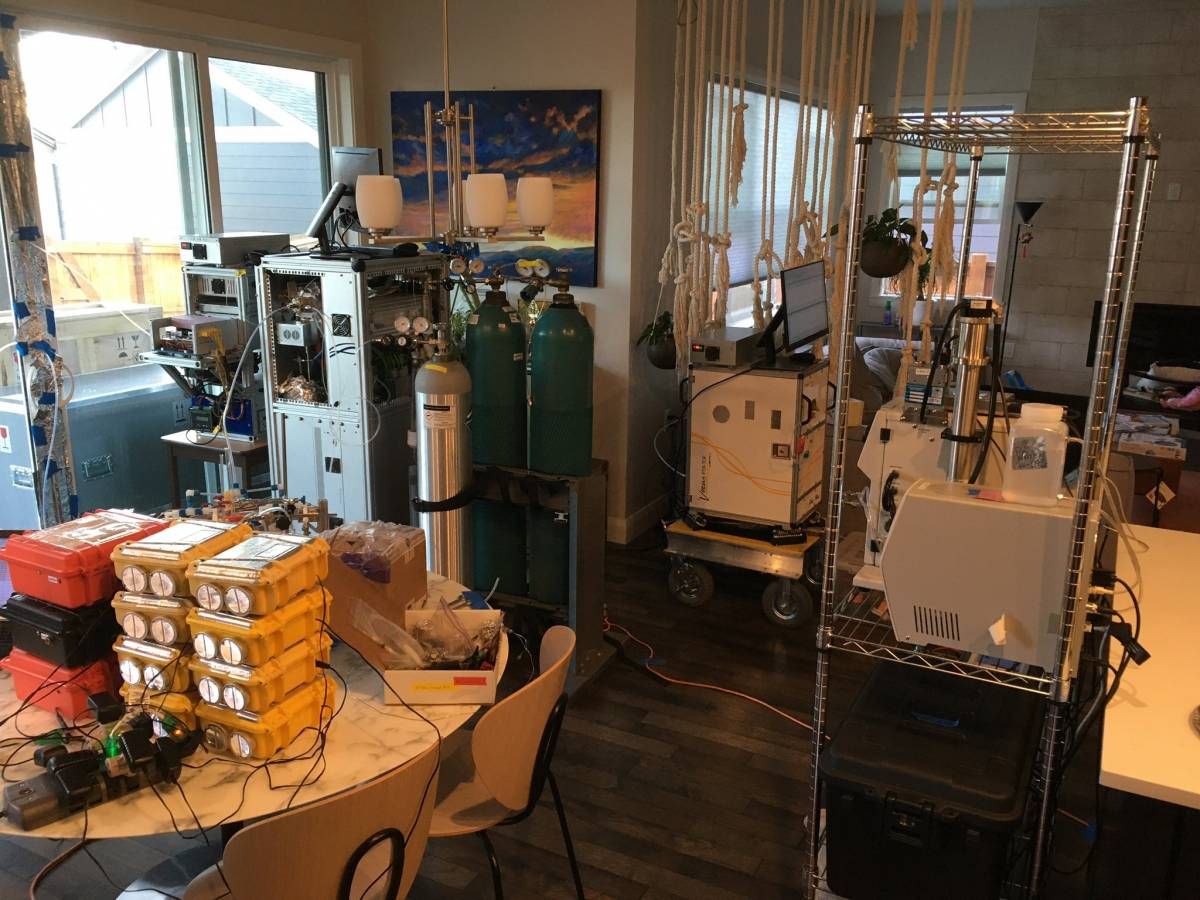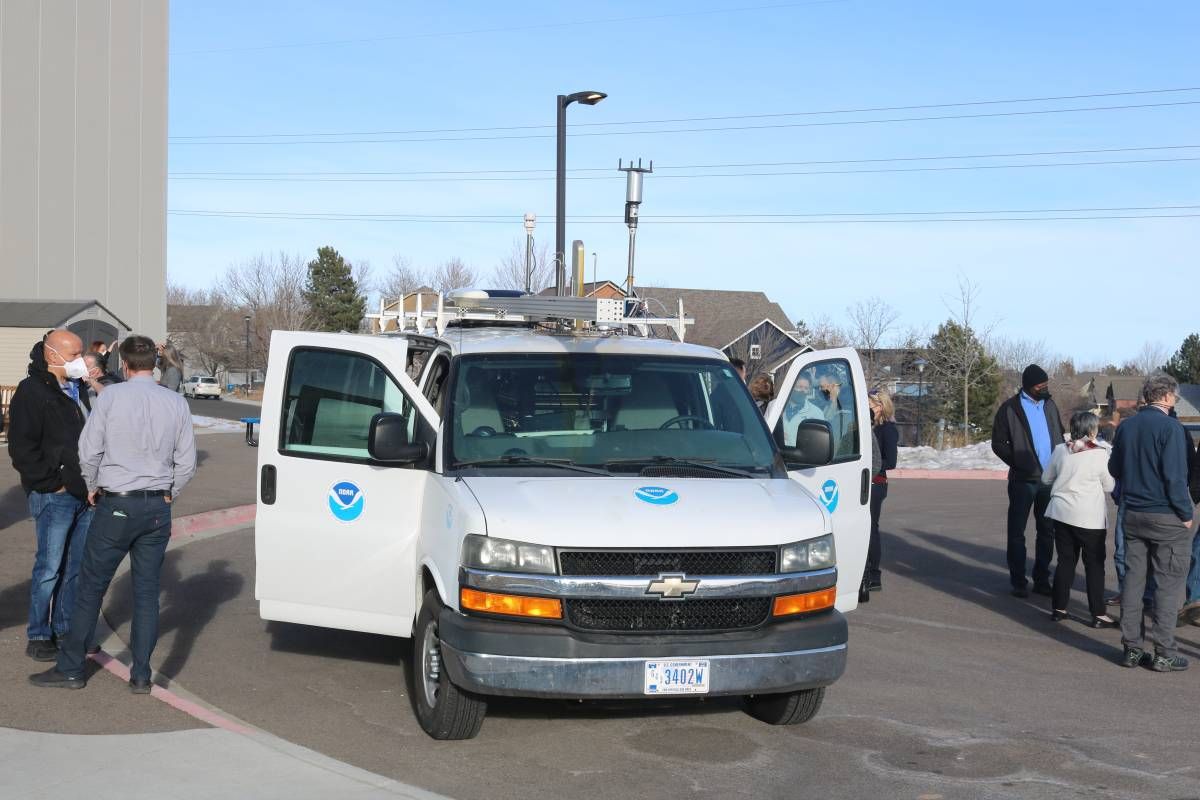How does Marshall Fire smoke affect indoor, outdoor air quality?
CIRES, CU Boulder and NOAA scientists move fast to understand the impacts of post-fire smoke on indoor and outdoor air quality

When the Marshall Fire tore through Superior and Louisville December 30, 2021, it destroyed more than 1,000 homes and damaged nearly 150 others. The smell of smoke lingers everywhere, outdoors and even inside, especially in homes directly downwind of fires.
Now, scientists from CIRES, CU Boulder and NOAA are installing instruments in surviving houses to understand the effects of smoke on indoor air quality. And they’re driving through neighborhoods in a mobile laboratory—a white NOAA van studded with instruments—to see what the outdoors atmosphere holds.
“The questions driving the work came from the community,” said Joost de Gouw, a CIRES Fellow, professor of Chemistry at CU Boulder, and the lead on the indoor air quality project. “People are worried about the impacts of that smoke on their health.”
Indoors
Within days of the fire, de Gouw and a team of air quality experts from across CU Boulder compiled and published a fact sheet on post-fire impacts, including recommendations for post-fire smoke cleanup in homes and a list of answers to frequently asked questions. At the same time, they began sharing ideas and assembling instruments that might be deployed to better understand what was happening between the walls of houses still standing.
“Some homes were exposed to high levels of pollutants for a long period of time,” said Marina Vance, an Assistant Professor in Mechanical Engineering. “Building materials acted like a sponge, soaking up compounds from the smoke.” Over time, and especially as homes warm up, those materials will re-release some of those compounds, “off-gassing” for weeks to months. And as people move around or clean their homes, fine particles that were deposited on surfaces will be re-suspended into the air.
Much of the existing research on smoke impacts focuses on wildfires that burned vegetation. But the Marshall Fire was different—it also burned building materials from homes and other structures, releasing gases and fine particles that aren’t as well studied by scientists.
“We began realizing that there just isn’t much science out there in terms of guidance, even for cleaning companies,” said Engineering Professor Michael Hannigan. “So we thought, why not try to do some science, really fast? We live in one of the places that’s arguably the best in the world for atmospheric science.”

The indoor setup.
De Gouw, Hannigan, Vance, Assistant Professor Colleen Reid from Geography and CIRES Associate Director for Science Christine Wiedinmyer quickly wrote a proposal to measure gases and fine particulates in fire-affected homes, and CIRES awarded the team a “rapid” CIRES Innovative Research Program seed grant. By January 8, the scientists had installed instruments in one Superior house just 100 feet from burned homes, taking detailed, 24/7 air-quality measurements. The data from these instruments will help the team identify the chemical composition of the air and dust left behind after the fire, and will allow the team to evaluate the outcomes of different cleanup and mitigation techniques—even those as simple as opening windows for a few hours. They’ve also installed other lower-cost instruments in 10 other Superior and Louisville homes, for comparison.
The indoor air quality team cautioned that it may be weeks before they can analyze and understand all the data and they are not likely to be able to definitely answer the most pressing question on people’s minds: Is it safe to return and live at home?
“We wish we could get to that answer, but I don’t know if we can,” Hannigan said, “But one of our goals is to assess reductions, how different scenarios of cleaning lead to improvements. We can probably do that.”
Outdoors
In some parts of Superior and Louisville, people notice the smoke smell only when they step outdoors. And that outdoors smell seems to change throughout the day, becoming more pungent at night, for example, and less noticeable mid-day.
Those are the smells that NOAA scientists are trying to decipher, after requests came in from Boulder County Public Health and the Colorado Department of Public Health and Environment. Scientists from both agencies have worked closely with NOAA’s air quality experts in the past. They know about NOAA’s Chemical Sciences Laboratory’s “mobile laboratory,” which supports some of the most sophisticated instruments around, capable of detecting tiny quantities of pollutants in the air.

The Outdoor setup: NOAA Chemical Sciences Laboratory mobile lab, deployed in a Superior neighborhood Jan. 12.
“We are able to go house-by-house, street-by-street to gauge what some of the pollutant sources are within the burn area,” said Jessica Gilman, a NOAA research chemist. She and her colleagues are looking at how atmospheric chemistry changes depending on area and proximity to burned homes, time of day, the wind (which can whip up soot and other debris), and other factors.
Matt Coggon, an atmospheric scientist with both NOAA and CIRES/CU Boulder, spent January 11 in the van, and said the team detected some impact of the fire on air quality in the morning, when winds were relatively high and whipped some pollutants into downwind air. But those fire-caused emissions were no higher than what the team typically sees as air pollution from other sources builds up during the day, Coggon said. “The increase we saw from everyone just driving around, using products, painting… that was comparable to the pollution we saw within the burn region.”
The data so far have been something of a relief, the team said. “So typically we are most interested when we observe enhancements of emissions, because that’s scientifically interesting,” said Chelsea Stockwell, CIRES/NOAA. “But here, we are not seeing very large enhancements and we are very glad, because that has lower impact on the community.”
Both teams of scientists cautioned that their data are not only incomplete, they will take time to assess, because this kind of research simply hasn’t been done before. Both teams are reporting results to state and county public health officials. Meanwhile, they advised homeowners to turn to insurance companies and the Boulder County Marshall Fire webpage for more information. Additional information can be found on this CIRES resource page, “How to Mitigate Post-Fire Smoke Impacts in Your Home.”